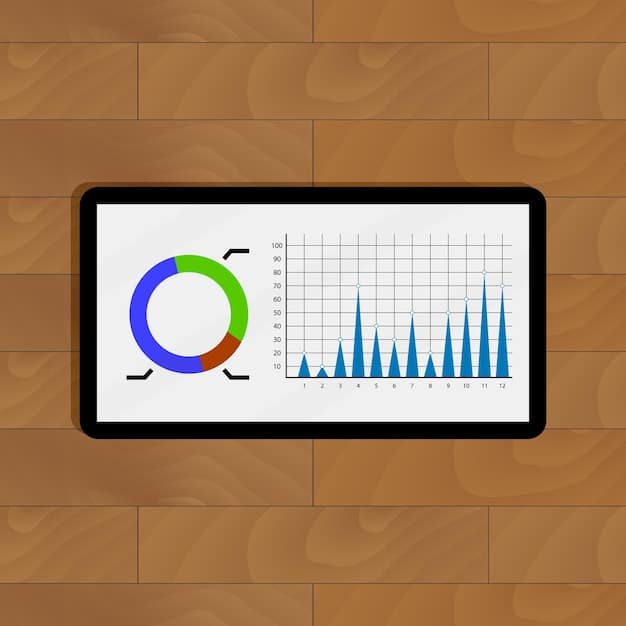Boost Website Conversion Rates by 15% in 3 Months with A/B Testing

Achieving a 15% increase in website conversion rates within three months is attainable through strategic A/B testing, focusing on iterative improvements across key user journey elements to optimize performance metrics effectively.
In the competitive digital landscape, every click and every visitor interaction counts. For businesses striving for growth, the ability to effectively convert website traffic into tangible outcomes – whether sales, leads, or sign-ups – is paramount. This guide delves into actionable strategies on how to increase website conversion rates by 15% in 3 months with A/B testing, offering a clear roadmap for measurable success.
Understanding the Foundation: What is A/B Testing?
A/B testing, also known as split testing, is a research methodology where two or more versions of a webpage or app are shown to different segments of website visitors at the same time. The goal is to determine which version performs better for a given conversion goal. This scientific approach allows marketers and web developers to make data-driven decisions rather than relying on guesswork or intuition.
The Scientific Approach to Conversion
Think of A/B testing as a continuous experiment. You formulate a hypothesis about what might improve your conversion rate, create a variant that incorporates that change, and then test it against your existing version (the control). The beauty of A/B testing lies in its ability to isolate variables. By changing only one element at a time, you can confidently attribute any performance difference to that specific alteration.
For example, if you change both the headline and the call-to-action button color simultaneously, and your conversion rate improves, you won’t know which specific change—or combination of changes—was responsible. This can lead to misleading conclusions and inefficient optimization efforts.
Key Principles of Effective A/B Testing
Effective A/B testing isn’t just about throwing random changes at your website. It requires careful planning, execution, and analysis.
- Clear Hypothesis: Every test should start with a specific hypothesis about why a change will lead to an improvement. For example, “Changing the call-to-action button color from blue to orange will increase clicks by 10% because orange stands out more.”
- Single Variable Testing: Test one element at a time to ensure accurate causality.
- Statistical Significance: Ensure your test runs long enough and gathers enough data to achieve statistical significance, meaning the results are not due to random chance.
- Iterative Process: A/B testing is not a one-time fix but an ongoing process of optimization.
A/B testing transforms conversion rate optimization from an art to a science. By systematically testing hypotheses and analyzing data, businesses can make informed decisions that lead to sustainable improvements. This methodical approach ensures that every change implemented is backed by evidence, paving the way for consistent growth.
Setting Realistic Goals and Identifying Key Metrics
Before diving into A/B testing, it’s crucial to establish clear, measurable goals. A 15% increase in conversion rates in three months is an ambitious but achievable target. Defining what “conversion” means for your specific website is the first step. Is it a purchase, a form submission, a download, or a sign-up? Your goal should align with your business objectives.
Defining Your Conversion Goal
Your primary conversion goal should be the most important action you want visitors to take on your website. Once you’ve identified this, you can then define micro-conversions – smaller steps that lead to the main goal. For instance, if your main goal is a purchase, micro-conversions might include adding an item to the cart, viewing a product page, or initiating checkout. Tracking both macro and micro-conversions provides a holistic view of user behavior and helps pinpoint specific friction points in the conversion funnel.
Key Performance Indicators (KPIs)
Beyond the conversion rate itself, other KPIs offer valuable insights into your website’s performance.
- Bounce Rate: The percentage of visitors who leave your site after viewing only one page. A high bounce rate suggests that visitors aren’t finding what they expect or that your content isn’t engaging.
- Average Session Duration: How long visitors spend on your site. Longer durations often indicate higher engagement.
- Pages Per Session: The number of pages a visitor views in a single session. More pages per session can suggest deeper exploration and interest.
- Cart Abandonment Rate: For e-commerce sites, this is the percentage of users who add items to their cart but don’t complete the purchase.
By monitoring these metrics in conjunction with your conversion rate, you gain a comprehensive understanding of user behavior. This allows you to identify areas for improvement and prioritize your A/B testing efforts. Establishing a baseline for these metrics before starting your A/B tests is essential to accurately measure the impact of your changes.
The clarity of your goals and the precision of your metrics will dictate the success of your A/B testing initiatives. Without a clear understanding of what you’re trying to achieve and how you’ll measure it, even the most innovative tests will fall short of their potential. It’s about setting a target and then systematically aiming for it.

Identifying High-Impact Areas for A/B Testing
To achieve a 15% conversion rate increase in three months, you need to prioritize testing areas that have the greatest potential impact. This involves analyzing your existing website data to uncover bottlenecks and user pain points. Heatmaps, session recordings, and analytics tools are invaluable for this.
Analyzing User Behavior
Before you start guessing what to test, observe how users interact with your site.
- Heatmaps: Show where users click, scroll, and spend the most time on a page. This can reveal elements that are being ignored or areas that are causing confusion.
- Session Recordings: Provide video playback of individual user sessions, allowing you to see exactly where users get stuck, abandon a process, or express frustration.
- Google Analytics (or similar): Dive into your analytics to identify pages with high exit rates, long load times, or unusual navigation patterns. The “Behavior Flow” report can be particularly insightful for understanding how users move through your site.
By understanding the “why” behind user behavior, you can formulate stronger hypotheses for your A/B tests. For instance, if session recordings reveal users struggling to find the “add to cart” button, testing its placement or visual emphasis becomes a high-priority item.
There are numerous elements on a typical website that can be A/B tested to improve performance. The trick is to focus on those with the highest potential return on very little investment.
Common High-Impact Areas for Testing
Several components consistently show significant potential for conversion rate improvements through A/B testing.
Headlines and Copy: Your headline is often the first thing visitors read. Testing different headlines, subheadings, and body copy can drastically impact engagement and conversion. Focus on clarity, benefit-orientation, and addressing user pain points.
Call-to-Action (CTA) Buttons: The design, color, text, and placement of your CTAs are critical. Testing variations like “Get Started Free” vs. “Start Your Free Trial” or button colors can yield substantial increases in clicks.
Forms: Long, complex forms often lead to abandonment. Test the number of fields, field labels, error messages, and form layout. Simplifying forms can significantly boost completion rates.
Images and Videos: Visuals are powerful. Experiment with different hero images, product photos, or the inclusion of explainer videos. Ensure your visuals are relevant, high-quality, and evoke the desired emotion or action.
Page Layout and Navigation: The overall structure of your pages and how users navigate your site affects usability. Test different arrangements of elements, menu structures, and the prominence of key information.
Pricing Pages: For products or services with varying price tiers, testing how pricing is presented, highlighting value propositions, or offering different payment options can influence conversions.
By focusing your initial A/B testing efforts on these high-impact areas, you increase the likelihood of achieving your 15% conversion rate growth within the three-month timeframe. Remember, the goal is not to randomly test everything, but to test the right things strategically.
Designing and Executing Your A/B Tests
Once you’ve identified your high-impact areas and formulated hypotheses, the next step is to carefully design and execute your A/B tests. This process requires attention to detail to ensure accurate and reliable results. Choosing the right A/B testing tool is a crucial first decision, as it will facilitate the creation of test variations and the tracking of their performance.
Choosing the Right A/B Testing Tool
There are many excellent A/B testing platforms available, each with its own strengths. Some popular options include:
- Google Optimize: A free tool that integrates seamlessly with Google Analytics, making it a powerful choice for many businesses. It allows for A/B, multivariate, and redirect tests.
- Optimizely: A robust enterprise-level platform offering advanced testing capabilities, personalization, and cross-channel optimization.
- VWO (Visual Website Optimizer): Known for its user-friendly visual editor and comprehensive suite of conversion optimization tools, including heatmaps and session recordings.
- Hotjar: While not a direct A/B testing tool, platforms like Hotjar provide invaluable insights through heatmaps, session recordings, and surveys that inform your A/B test hypotheses.
The best tool for you will depend on your budget, technical expertise, and the complexity of your testing needs. Regardless of the tool, ensure it allows for proper audience segmentation, statistical significance calculation, and clear reporting.
Key Steps in A/B Test Execution
Following a structured approach to test execution is vital for valid results.
1. Create Your Variations: Based on your hypothesis, design the alternative version (or versions) of the element you’re testing. Use your A/B testing tool’s visual editor or code editor to implement these changes. Ensure that only the variable in question is altered between the control and the variant.
2. Define Your Audience: Determine which segment of your audience will see the test. For instance, you might target only new visitors, visitors from a specific geographic region, or those who have previously added an item to their cart. Randomization is key to ensuring that the two groups (control and variant) are as similar as possible.
3. Set Up Your Goals: Configure your A/B testing tool to track the specific conversion goals and micro-conversions relevant to your test. This is how the tool will determine which version performs better.
4. Determine Test Duration and Sample Size: Do not end a test prematurely. Use a statistical significance calculator to determine the required sample size and estimated test duration based on your current conversion rates, expected improvement, and traffic volume. Running tests for at least one full business cycle (e.g., 1-2 weeks) can help account for weekday vs. weekend traffic variations.
5. Launch the Test: Once everything is configured, launch your A/B test. Monitor it closely in the initial stages to ensure there are no technical issues or unexpected behaviors.
6. Monitor and Analyze Results: Continuously monitor the test’s performance. Only declare a winner once statistical significance has been reached. Look beyond the primary conversion goal; analyze secondary metrics and qualitative feedback too.
Careful execution ensures that your A/B test results are reliable and actionable. Skipping steps or rushing the process can lead to false positives or negatives, undermining your optimization efforts.
Analyzing Results and Drawing Actionable Insights
Launching an A/B test is only half the battle; the real work lies in analyzing the results to draw actionable insights. Understanding statistical significance, interpreting unexpected outcomes, and identifying the “why” behind the numbers are crucial steps in this phase. This analytical rigor transforms raw data into strategic decisions.
Understanding Statistical Significance
Statistical significance tells you how likely it is that the observed difference between your control and variant is due to chance. A common threshold is 95%, meaning there’s less than a 5% probability that the results occurred randomly.
- Don’t Act Prematurely: Resist the urge to crown a winner before statistical significance is reached. Ending a test early can lead to misleading conclusions based on insufficient data.
- Consider Confidence Intervals: A confidence interval provides a range within which the true conversion rate likely falls. Overlapping confidence intervals between your control and variant suggest that the difference may not be statistically significant.
- Impact of Traffic Volume: Low traffic websites may need to run tests for longer durations to gather enough data for statistical significance. Be patient.
Many A/B testing tools automatically calculate statistical significance, but understanding the underlying principles empowers you to interpret these numbers correctly.
Interpreting Results Beyond the Numbers
While statistical significance is critical, it doesn’t tell the whole story. Dig deeper into the data to understand user behavior.
Segment Your Audience: Did the variant perform better for all users, or only for specific segments (e.g., mobile users, new visitors, users from organic search)? Segmenting results can uncover nuanced insights and reveal opportunities for targeted optimization.
Look at Secondary Metrics: Beyond your primary conversion goal, how did the variant affect other KPIs like bounce rate, average session duration, or pages per session? A variant might increase sign-ups but also significantly increase bounce rate, indicating a potential trade-off or a poor user experience for non-converters.
Qualitative Data: Complement quantitative A/B test results with qualitative insights. Session recordings, heatmaps, and user surveys can help explain “why” a particular variant performed better or worse. For instance, a variant might have a lower conversion rate, but session recordings reveal users being confused by a new layout. This qualitative feedback provides context to the numbers.
Unexpected Outcomes: Sometimes, your hypothesis might be proven wrong, or a variant performs worse than the control. This isn’t a failure; it’s a learning opportunity. Analyze why the change didn’t work. Was the hypothesis flawed? Was the variant poorly implemented? These insights prevent you from repeating mistakes and guide future iterations.
The goal is not just to find a winning variant but to understand why it won. This deeper understanding will inform your ongoing optimization strategy, allowing you to replicate successful patterns and avoid ineffective ones across your website. Each test, whether a win or a loss, contributes to your knowledge base and refines your approach to conversion rate optimization.

Iterating and Scaling Your Success
Achieving a 15% increase in conversion rates within three months is not a sprint; it’s a series of iterative improvements. Once you’ve analyzed the results of your A/B tests, the next crucial step is to implement the winning variations, document your learnings, and continue the optimization cycle. This iterative process ensures sustained growth and avoids complacency.
Implementing Winning Variations
When a variant proves to be a statistically significant winner, implement it permanently on your website. This means replacing the control version with the improved variant for all users. Be sure to monitor its performance post-implementation to ensure the positive trend continues under full traffic conditions. Sometimes, changes that work well in a test environment might behave differently at scale, so continued monitoring is essential.
Documenting Your Learnings
Every A/B test, regardless of its outcome, provides valuable insights. Maintain a detailed log or knowledge base of all your tests. For each entry, include:
- Hypothesis: What you expected to happen and why.
- Variations Tested: Details of the control and all variants.
- Key Metrics Monitored: Primary and secondary KPIs.
- Test Duration and Sample Size: How long the test ran and how many users participated.
- Results and Statistical Significance: The quantitative outcome.
- Key Findings and Learnings: The qualitative insights derived from the test. Why did it win/lose? What did you learn about user behavior?
- Next Steps: What further tests or optimizations are suggested by these results?
This documentation serves as an invaluable resource, preventing the repetition of failed tests and building a repository of best practices specific to your audience and website. It fosters a culture of continuous learning and data-driven decision-making.
The Iterative Optimization Cycle
Conversion rate optimization is a continuous journey. As soon as one test concludes and its winning variant is implemented, the cycle begins anew.
1. Recap and Brainstorm: Review your documentation. What did you learn? What new hypotheses can you form based on recent insights?
2. Prioritize New Tests: Not all tests are created equal. Use your understanding of user behavior and potential impact to prioritize the next set of A/B tests. Focus on areas that present the biggest friction points or offer the highest potential return.
3. Design and Execute: Create new variations and launch your next A/B tests, meticulously following the steps outlined previously.
4. Analyze and Learn: Interpret the results, document your findings, and repeat the process.
This continuous cycle of testing, learning, and iterating is what drives sustainable improvements. A 15% conversion rate increase in three months is an excellent initial goal, but to maintain and even accelerate that growth, you must embed A/B testing into your ongoing digital marketing strategy. Scaling success isn’t just about implementing winning variations; it’s about building a robust, data-driven optimization machine that consistently uncovers new ways to enhance your website’s performance.
Common Pitfalls to Avoid in A/B Testing
While A/B testing offers a clear path to conversion rate optimization, several common pitfalls can derail your efforts. Being aware of these traps can help you conduct more effective tests and avoid making incorrect conclusions. A structured approach, combined with a healthy dose of skepticism, is key to navigating these challenges.
Ignoring Statistical Significance
This is perhaps the most common and damaging mistake. Ending a test too early or acting on results that aren’t statistically significant is akin to tossing a coin and assuming it’s biased after just a few flips.
- Premature Optimization: Don’t look at the data daily expecting a clear winner. A/B tests need time and traffic to normalize and show reliable results.
- Small Sample Sizes: If your traffic is low, it will take longer to achieve significance. Don’t rush it; otherwise, you’ll be making decisions based on noise, not signal.
- Peeking: Resist the urge to “peek” at results too often, as this can lead to premature conclusions. Let the test run its course.
Ensure your testing tool provides statistical significance data, and understand what it means before making any decisions.
Testing Too Many Variables At Once
The fundamental principle of A/B testing is to isolate the impact of a single change. Trying to test multiple elements simultaneously (e.g., a new headline, button color, and image) means you won’t know which specific element was responsible for the observed change. While multivariate testing exists for this purpose, it requires significantly more traffic and is more complex to set up and analyze. For most beginners, stick to A/B tests, changing only one thing at a time.
Not Having a Clear Hypothesis
Launching a test just to see what happens is a waste of resources. Every test should be driven by a specific, testable hypothesis based on research (user behavior analysis, qualitative feedback, industry best practices). Without a hypothesis, you won’t know what you’re trying to prove or disprove, making it difficult to learn from the results. A good hypothesis follows the “If… Then… Because…” structure.
Ignoring External Factors
Your website doesn’t exist in a vacuum. External factors can influence your test results.
- Seasonal Trends: Conversions might naturally fluctuate due to holidays, economic conditions, or industry-specific seasons. Run tests during periods that accurately reflect your typical user behavior.
- Marketing Campaigns: A new ad campaign driving different traffic segments to your site can skew results. Try to avoid running major A/B tests simultaneously with large, unrelated marketing pushes.
- Technical Issues: Site downtime, slow loading speeds, or other technical glitches during a test can invalidate your results. Monitor your site’s health throughout the testing period.
Failing to Document and Learn
As discussed, every test is a learning opportunity. If you don’t document your hypotheses, results, and insights, you risk repeating failed tests or missing opportunities to build on successful ones. A robust documentation process turns individual tests into cumulative knowledge.
By consciously avoiding these common pitfalls, you can ensure your A/B testing efforts are more efficient, produce more reliable insights, and ultimately contribute more effectively to your goal of increasing website conversion rates. It’s about precision and patience.
| Key Area | Brief Description |
|---|---|
| 📊 A/B Testing Basics | Systematic testing of page variations to find optimal designs for conversion. |
| 🎯 Goal Setting | Define clear conversion objectives and KPIs to measure success effectively. |
| 🔍 High-Impact Areas | Prioritize testing on CTAs, forms, headlines, and visuals for significant gains. |
| 📈 Iterative Process | Continuous testing, analysis, and implementation are key for sustained growth. |
FAQs: Increasing Website Conversion Rates with A/B Testing
▼
A “good” conversion rate varies significantly by industry, traffic source, and type of conversion. While average e-commerce conversion rates hover around 2-3%, some industries might see 5% or even 10% as typical. The goal should always be continuous improvement over your existing baseline, rather than fixating on an arbitrary number.
▼
The duration of an A/B test depends on your website’s traffic volume and the expected lift. It’s crucial to run tests until statistical significance is achieved, typically 95% or higher. For most websites, this means running a test for at least one to two business cycles (e.g., 7-14 days) to account for weekly traffic fluctuations and accumulate enough data.
▼
No, it is generally recommended to A/B test one variable at a time. Testing multiple variables simultaneously makes it impossible to definitively attribute improvements or declines to a specific change. While multivariate testing exists for complex scenarios, it requires higher traffic and more sophisticated analysis, making single-variable A/B testing ideal for most optimization efforts.
▼
If your A/B test concludes with no statistically significant difference, it simply means your hypothesis was not proven in this instance. This is still a valuable learning. It indicates that the change you made did not have a measurable impact. Document these findings and use them to inform your next hypothesis, perhaps by testing a more contrasting variant or a different element altogether.
▼
A/B testing should be an ongoing, continuous process rather than a one-time activity. The frequency depends on your website’s traffic, resources, and the number of hypotheses you have. Aim to run tests consistently, learning from each experiment and implementing winning variations to sustain and accelerate your conversion rate optimization efforts over time.
Conclusion
Increasing website conversion rates by 15% in three months is an aggressive but entirely achievable goal through the diligent application of A/B testing. This systematic approach, rooted in data-driven decision-making, allows businesses to move beyond guesswork, uncovering what truly resonates with their audience. By meticulously defining goals, analyzing user behavior to identify high-impact areas, executing tests with precision, and rigorously analyzing results, companies can make iterative improvements that compound over time. Embracing A/B testing as an ongoing strategy, and avoiding common pitfalls, is essential for not just reaching, but sustaining and exceeding ambitious conversion targets. The journey of optimization is continuous, but with A/B testing as your compass, significant growth is well within reach.





